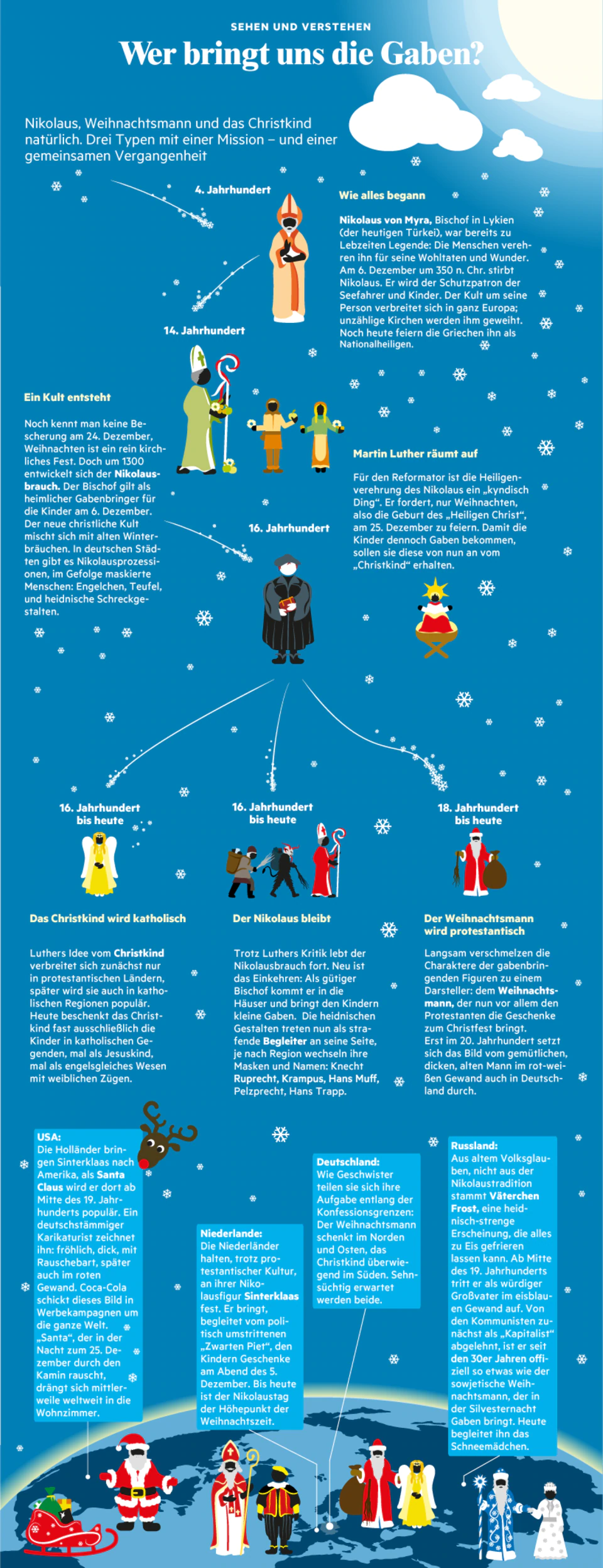On St. Nicholas Day
Nikolaus, Christkind, Santa Claus – who brings the gifts where and when
Nicholas, Santa Claus or Christ Child – who brings the presents for Christmas differs depending on the region or denomination.
© star infographic
Children look forward to one thing above all at Christmas: gifts. Whether they come from Santa Claus, Santa Claus or Christ Child varies depending on the region or denomination. See which parcel delivery service is in use where.
Nicholas, Santa Claus and the Christ Child are three guys with a mission – and a common past. It has its origins in the fourth century:
Nikolaus von Myra, bishop in Lycia (today’s Turkey), was already a legend during his lifetime: people revere Nikolaus for his benefits and miracles. Nicholas dies on December 6th around 350 AD. He becomes the patron saint of sailors and children. The cult around his person spreads across Europe; innumerable churches are consecrated to him. The Greeks still celebrate him today as a national saint.
In the 14th century, there was still no gift giving on December 24th, Christmas is a purely church festival. But around 1300 the custom of Nicholas develops. The bishop is considered to be the secret bringer of gifts for the children on December 6th. The new Christian cult mixes with old winter customs. In German cities there are processions for Nicholas, followed by masked people: angels, devils, and pagan horror figures.
Martin Luther cleans up and brings the Christ Child into play instead of Nicholas
For the reformer Martin Luther, in the 16th century, the veneration of saints was a “kyndisch thing”. He demands that only Christmas, the birth of the “Holy Christ”, be celebrated on December 25th. So that the children still receive gifts, they should from now on receive them from the “Christ Child”.
Luther’s idea of the Christ Child first spread only in Protestant countries, later it also became popular in Catholic regions. Nowadays the Christ Child almost exclusively gives presents to children in Catholic areas, sometimes as Jesus, sometimes as angelic beings with female features.
Santa Claus survives too – and faces competition from Santa Claus
Despite Luther’s criticism, the St. Nicholas tradition lives on. The stopping off is new: As a kind bishop, Nicholas comes into the houses and brings the children little gifts. The pagan figures now step by his side as punitive companions, their masks and names change depending on the region: Knecht Ruprecht, Krampus, Hans Muff, Pelzprecht, Hans Trapp.
From the 18th century onwards, the characters of the gift-bringing figures slowly merge into one actor: Santa Claus, who now primarily brings the gifts to the Protestants for Christmas. It was not until the 20th century that the image of the cozy, fat old man in a red and white robe – who optically still strongly resembles St. Nicholas – also caught on in Germany.
Germany today: Santa Claus and Christ Child share the job, Nicholas comes earlier
Nowadays, like siblings, the Christ Child and Santa Claus share their duties along denominational boundaries: Santa Claus gives presents on Christmas Eve in the north and east, the Christ Child predominantly in the south. Both are eagerly awaited. Nicholas is the vanguard and in some places comes to the children on December 6th, St. Nicholas Day.
Nikolaus, Christkind, Santa Claus: You can find a clear overview of the history of the gift bringers in the large star graphic below:

© Graphic: Andrew Timmins / Natalie Isser
Netherlands: Sinterklaas and “Zwarter Piet”
Despite their Protestant culture, the Dutch cling to their figure of Nicholas: Sinterklaas. Accompanied by the politically controversial “Zwarten Piet”, he brings presents to the children on the evening of December 5th. To this day, St. Nicholas’ Day is the highlight of the Christmas season and the main gift day in the neighboring country. Because many prices fell afterwards, many Germans took the opportunity to buy their Christmas gifts in the neighboring country.
USA: Santa Claus rushes through the chimney
The Dutch brought Sinterklaas to America, where he became popular as Santa Claus from the middle of the 19th century. A caricaturist of German descent draws him: happy, fat, with a long beard, later also in a red robe. Coca-Cola is sending this image in advertising campaigns around the world. “Santa”, who rushes through the fireplace on the night of December 25th, is now crowding into living rooms all over the world.
Russia: Father Frost comes a few days later
From old folk beliefs, not from the tradition of St. Nicholas, Father Frost comes, a pagan, strict appearance that can freeze everything to ice. From the middle of the 19th century he appeared as a worthy grandfather in an ice-blue robe. Initially rejected by the communists as a “capitalist”, since the 1930s he has officially been something like the Soviet Santa Claus who brings gifts on New Year’s Eve. Today the snow girl is with him.

